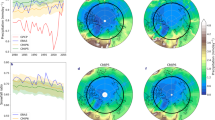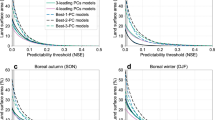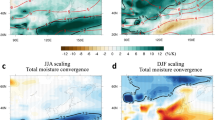Abstract
Climate models project a strong increase in Arctic precipitation over the coming century1, which has been attributed primarily to enhanced surface evaporation associated with sea-ice retreat2. Since the Arctic is still quite cold, especially in winter, it is often (implicitly) assumed that the additional precipitation will fall mostly as snow3. However, little is known about future changes in the distributions of rainfall and snowfall in the Arctic. Here we use 37 state-of-the-art climate models in standardized twenty-first-century (2006–2100) simulations4 to show a decrease in average annual Arctic snowfall (70°–90° N), despite the strong precipitation increase. Rain is projected to become the dominant form of precipitation in the Arctic region (2091–2100), as atmospheric warming causes a greater fraction of snowfall to melt before it reaches the surface, in particular over the North Atlantic and the Barents Sea. The reduction in Arctic snowfall is most pronounced during summer and autumn when temperatures are close to the melting point, but also winter rainfall is found to intensify considerably. Projected (seasonal) trends in rainfall and snowfall will heavily impact Arctic hydrology (for example, river discharge, permafrost melt)5,6,7, climatology (for example, snow, sea-ice albedo and melt)8,9 and ecology (for example, water and food availability)5,10.
This is a preview of subscription content, access via your institution
Access options
Access Nature and 54 other Nature Portfolio journals
Get Nature+, our best-value online-access subscription
$29.99 / 30 days
cancel any time
Subscribe to this journal
Receive 12 print issues and online access
$209.00 per year
only $17.42 per issue
Buy this article
- Purchase on Springer Link
- Instant access to full article PDF
Prices may be subject to local taxes which are calculated during checkout




Similar content being viewed by others
References
Collins, M. et al. in Climate Change 2013: The Physical Science Basis (eds Stocker, T. F. et al.) 1029–1136 (IPCC, Cambridge Univ. Press, 2013).
Bintanja, R. & Selten, F. M. Future increases in Arctic precipitation linked to local evaporation and sea ice retreat. Nature 509, 479–482 (2014).
Liu, J. P., Curry, J. A., Wang, H., Song, M. & Horton, R. M. Impact of declining Arctic sea ice on winter snowfall. Proc. Natl Acad. Sci. USA 109, 4074–4079 (2012).
Taylor, K. E., Stouffer, R. J. & Meehl, G. A. An overview of CMIP5 and the experiment design. Bull. Am. Meteorol. Soc. 93, 485–498 (2012).
ACIA Arctic Climate Impact Assessment (Cambridge Univ. Press, 2005).
Berghuijs, W. R., Woods, R. A. & Hrachowitz, M. A precipitation shift from snow towards rain leads to a decrease in streamflow. Nat. Clim. Change 4, 583–586 (2014).
Nilsson, C., Polvi, L. E. & Lind, L. Extreme events in streams and rivers in arctic and subarctic regions in an uncertain future. Freshwat. Biol. 60, 2535–2546 (2015).
Callaghan, T. V. et al. The changing face of Arctic snow cover: a synthesis of observed and projected changes. Ambio 40, 17–31 (2011).
Screen, J. A. & Simmonds, I. Declining summer snowfall in the Arctic: causes, impacts and feedbacks. Clim. Dynam. 38, 2243–2256 (2012).
Hansen, B. B. et al. Climate events synchronize the dynamics of a resident vertebrate community in the high Arctic. Science 339, 313–315 (2013).
Held, I. M. & Soden, B. J. Robust responses of the hydrological cycle to global warming. J. Clim. 19, 5686–5699 (2006).
Bengtsson, L. et al. The changing atmospheric water cycle in polar regions in a warmer climate. Tellus A 63, 907–920 (2011).
Min, S. K., Zhang, X. & Zwiers, F. Human-induced Arctic moistening. Science 320, 518–520 (2008).
Doyle, S. H. et al. Amplified melt and flow of the Greenland ice sheet driven by late-summer cyclonic rainfall. Nat. Geosci. 8, 647–656 (2015).
Bintanja, R. & van der Linden, E. C. The changing seasonal cycle in the Arctic. Nat. Sci. Rep. 3, 1556 (2013).
Mankin, J. S. & Diffenbaugh, N. S. Influence of temperature and precipitation variability on near-term snow trends. Clim. Dynam. 45, 1099–1116 (2015).
Räisänen, J. Warmer climate: less or more snow? Clim. Dynam. 30, 307–319 (2008).
Holland, M. M. et al. Projected changes in Arctic Ocean freshwater budgets. J. Geophys. Res. 112, G04S55 (2007).
Aoki, T., Hachikubo, A. & Hori, M. Effects of snow physical parameters on shortwave broadband albedos. J. Geophys. Res. 108, 4616 (2003).
Bulygina, O. N., Arzhanova, N. M. & Groisman, P. Y. Icing conditions over Northern Eurasia in changing climate. Environ. Res. Lett. 10, 025003 (2015).
Serreze, M. C. & Barry, R. G. The Arctic Climate System 385 (Cambridge Univ. Press, 2005).
Kapnick, S. B. & Delworth, T. L. Controls of global snow under a changed climate. J. Clim. 26, 5537–5562 (2013).
Screen, J. A. & Simmonds, I. The central role of diminshing sea ice in recent Arctic temperature amplification. Nature 464, 1334–1337 (2010).
Krasting, J., Broccoli, A., Dixon, K. & Lanzante, J. Future changes in northern hemisphere snowfall. J. Clim. 26, 7813–7828 (2013).
Kobayashi, S. et al. The JRA-55 reanalysis: general specifications and basic characteristics. J. Meteorol. Soc. Jpn 93, 5–48 (2015).
Westermann, S., Boike, J., Langer, M., Schuler, T. V. & Etzelmüller, B. Modeling the impact of wintertime rain events on the thermal regime of permafrost. Cryosphere 5, 1697–1736 (2011).
Nowak, A. & Hodson, A. Hydrological response of a high-Arctic catchment to changing climate over the past 35 years: a case study of Bayelva watershed, Svalbard. Polar Res. 32, 19691 (2013).
Kohler, J. & Aanes, R. Effect of winter snow and ground-icing on a Svalbard reindeer population: results of a simple snowpack model. Arct. Antarct. Alp. Res. 36, 333–341 (2004).
Kaplan, J. O. et al. Climate change and Arctic ecosystems: 2. Modeling, paleodata-model comparisons, and future projections. J. Geophys. Res. 108, 8171 (2003).
Kaplan, J. O. & New, M. Arctic climate change with a 2 °C global warming: timing, climate patterns and vegetation change. Climatic Change 79, 213–241 (2006).
Acknowledgements
We acknowledge the World Climate Research Programme’s Working Group on Coupled Modelling, which is responsible for CMIP, and we thank all climate-modelling groups for producing and making available their model output. For CMIP the US Department of Energy’s Program for Climate Model Diagnosis and Intercomparison provides coordinating support and led the development of software infrastructure in partnership with the Global Organization for Earth System Science Portals. We are grateful to the EC-Earth consortium for their contribution to the development of the Earth System Model EC-Earth. We thank M. Loonen and F. Selten for their comments on earlier versions of the manuscript.
Author information
Authors and Affiliations
Contributions
R.B. developed the ideas that led to this paper. R.B. analysed the climate model simulations, while O.A. analysed the reanalyses data. R.B. wrote the main paper, with input from O.A. All authors discussed the results and implications and commented on the manuscript at all stages.
Corresponding author
Ethics declarations
Competing interests
The authors declare no competing financial interests.
Supplementary information
Supplementary Information
Supplementary Information (PDF 2084 kb)
Rights and permissions
About this article
Cite this article
Bintanja, R., Andry, O. Towards a rain-dominated Arctic. Nature Clim Change 7, 263–267 (2017). https://doi.org/10.1038/nclimate3240
Received:
Accepted:
Published:
Issue Date:
DOI: https://doi.org/10.1038/nclimate3240
This article is cited by
-
Influence of snowmelt on increasing Arctic river discharge: numerical evaluation
Progress in Earth and Planetary Science (2024)
-
The impacts of climate change on coastal groundwater
Nature Reviews Earth & Environment (2024)
-
Projected increase in global runoff dominated by land surface changes
Nature Climate Change (2023)
-
Continentality determines warming or cooling impact of heavy rainfall events on permafrost
Nature Communications (2023)
-
Fishing motives and economic effects of climate change: an application on Arctic char in northern Sweden
Journal of Bioeconomics (2023)



